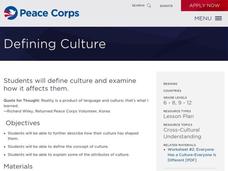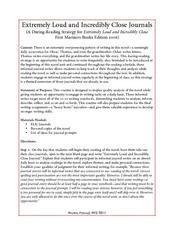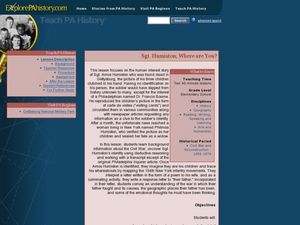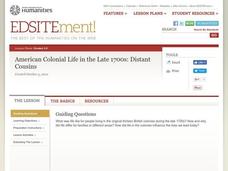Virginia Department of Education
Numbers in a Name
What's in a name? Pupils create a data set from the number of letters in the names of classmates. Each group then takes the data and creates a visual representation, such as a histogram, circle graph, stem-and-leaf plot, etc.
Curated OER
Defining Culture
Young scholars examine the role that culture plays in forming beliefs and behaviors. In this culture lesson, students describe the attributes of their culture and explain how their culture shapes them.
Curated OER
Extremely Loud and Incredibly Close: Journals
Like the characters in Jonathan Safran Foer’s novel, class members write frequently with a series of journal topics that form the basis of the final writing assignment about their personal “heavy boots.” Alas, no list of topics is...
Pennsylvania Department of Education
Giving Things a Name
Young scholars label images seen on an interactive website. In this early writing lesson, students do their best to write the name of the object seen on the screen.
Curated OER
Citizens for Responsible Change
Third graders write a petition to a school figure, get signatures from other students, share the petition with the appropriate authority, and then work as leaders to carry out the group's solution.
Curated OER
How to Choose Articles
In this language arts worksheet, students read detailed information that helps students choose correct articles in their writing. Students learn about nouns that refer to one unique thing, countable nouns, uncountable nouns, proper nouns...
Curated OER
Sgt. Humiston, Where are You?
Students become familiar with the events of the Civil War. In this identification lesson, students use deductive reasoning to understand how the deceased soldier was identified. Students view primary documents for information about the...
Curated OER
Do You Haiku? We Do!
Third graders try their hands at writing Haiku, a form of Japanese poetry. Haiku is usually 17 syllables in three-line form. This engaging lesson has many excellent worksheets and website imbedded in the plan. They share their finished...
Curated OER
Our Zoo Friends
First graders plan and create a model zoo depicting the natural habitats of animals. Their models include animals and a display of written factual information about the animals. Students present their project by conductig a tour of...
Curated OER
Drugonyms
Students research information about the effects of drug abuse. They take a quiz, conduct Internet research and write a "drugonym" where each letter in the name of an assigned drug begins a new sentence or paragraph describing properties...
Curated OER
Greetings and Introductions
Students recite common forms of courtesy, greetings and leave takings appropriate to the time of day. They practice identiying the differences in forms of address for age and rank. Pupils are each given a copy of the "Greetings and...
Curated OER
Science Notebooks
Teachers can use science notebooks and other forms of writing to help students improve their understanding of scientific concepts.
Curated OER
The Very Hungry Caterpillar - Collage Technique
First graders listen to the story The Hungry Caterpillar, then sequentially organize their own re-writing and re-creating of the story. They construct illustrations for their book using the collage technique Eric Carle used in his...
Curated OER
A Picture is Worth a Thousand Words: Public Views of Lincoln
Students write a letter in the voice of Abraham Lincoln. In this history lesson, students interpret the way the public viewed Lincoln during various times by examining political cartoons and images. Students write a letter in the voice...
Curated OER
Language Arts: Digital Commercials
Students create commercials using a digital camera. After brainstorming their ideas, they spend three days writing their commercials. Students practice and edit their commercials and then present them for review.
Curated OER
"What is an American?"
Eleventh graders ponder about what it means to be an "American." They discuss the impact of an author's word choice and sentence structure on text. They identify some major themes and development of the Letters... Compose paragraphs and...
Curated OER
We Are One World
Learners access prior knowledge to choose a country and research the living conditions in that country. In this living conditions lesson, students recognize the differences and similarities of conditions of another country to ours....
Curated OER
Where the Buffalo Roam
Students lear about energy, energy efficiency and consumption. They measure energy use, graph the date, write a letter then design and present a PowerPoint on the topic.
Curated OER
American Colonial Life in the Late 1700s: Distant Cousins
Students explore daily life and its influences in the late 1700s for two families in different colonies- Delaware and Massachusetts by becoming historical detectives. After gathering information from artifacts to make inferences about...
Curated OER
A Sea-nic Perspective
Students brainstorm topics related to the health of our world's oceans. They create presentations about specific issues affecting oceans for display in a classroom exhibit. They write letters of invitation to guests to view the exhibit.
Curated OER
The Problem with Prejudice
Third graders read and discuss "The Hangman" by Maurice Ogden and answer questions about the poem. They list things they can do to combat prejudice using each of the letters in the word and create a small poster with a slogan against...
Curated OER
The Three Branches of Government
Students complete a unit on the three branches of government. They compare/contrast the three branches of government, write a letter or e-mail to an executive in the Federal Government, and develop outlines for historical documents.
Curated OER
The Sonnet Challenge
High schoolers are given information about two popular sonnet forms-English and Italian. They are given the rules for writing a sonnet. Students are asked what type of sonnet they would use. They are each given a sheet of paper and...
Curated OER
Story Telling with Black & White Photography
4th-8th graders will explore Wright Morris' photography and create their own black and white photographs. They will then use the photographs to portray a message they want communicated by writing a narrative telling a story about the...

























